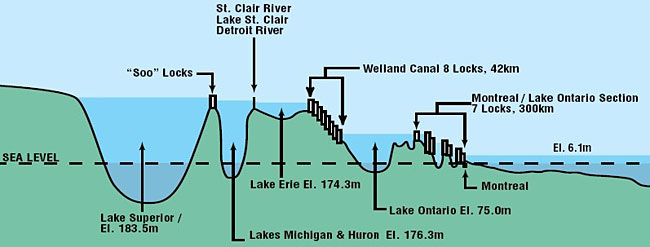1680
A canal to
bypass the Lachine Rapids around
Montreal & Lak St Louis was tried.
This project was spear headed by Dollier de Casson. He was the Superior
of the Sulpician Seminary in Montreal.
This was not successful
1779
A great feat
was made when a canal was begun to be made to have passage between Lak St
Francis & Lak St. Louis. It was the
Royal Army Engineers to commence and finish this undertaking. The Canals depth is at 0.76m. There are 5 locks. This project was completed by 1783.
1824
A canal with
7 locks was completed. At first it was
known as the Casson Canal. However the
name has been changed to Lachine Canal
*Side Note
taken from The Old Welland Canals Field Guide
http://www.oldwellandcanals.wikidot.com/feeder-canal
“The Feeder Canal was originally
built in 1829 to bring water from the Grand River to the First Welland Canal.
Over the years, however, the canal came to serve a much greater role as a shipping
canal, even while the First and Second Welland Canals were taken out of
operation.
The best way to understand the
feeder canal is to make sense of the long series of events that changed how the
canal was used.
- 1829 - A dam is built on the Grand River at Dunnville. Raising the water level, the feeder canal is dug to bring water from behind the dam to the First Welland Canal in Port Robinson some 40 km away.
- 1833 - Part of the Feeder Canal is incorporated into the First Welland Canal which is extended to Lake Erie. The Feeder Canal now ends just south of Welland.
- 1842-1845 - The Second Welland Canal is built. The Feeder Canal is enlarged to allow shipping along its route. The upgrade gives the Second Welland Canal two routes to Lake Erie.
- 1845-1850 - The Feeder Canal is used as the main channel while the Port Colborne route is deepened. A "Junction Lock" is built where the feeder canal empties into the Welland Canal. The feeder is also extended to Port Maitland where another lock is built to lower boats to the level of Lake Erie.”
1829
A schooner
known as Ann and Jane was the first to navigate the almost completed Welland
Canal.
1833
Welland
Canal is now Completed with a system of 40 locks. These are still wooden locks. It is relatively long at 43.5 km.
These dates
for the seaway is significant if your Ancestors had work with the canal
systems. So it could be your ancestors
did not come to Western Canada as Loyalist.
Instead they could have been part of these very large projects. Curious to know if Census records picked up
these workers.
With all the
migration that follows large construction projects there to can lead answers
into family migration patterns.
Please read
more about the canals at:
Information comes from St. Lawrence Seaway
: From the Canadian Geographic Magazine July/August 2009, Inland
superhighway: 300 years of history. http://www.canadiangeographic.ca/magazine/ja09/sw_timeline.asp
No comments:
Post a Comment